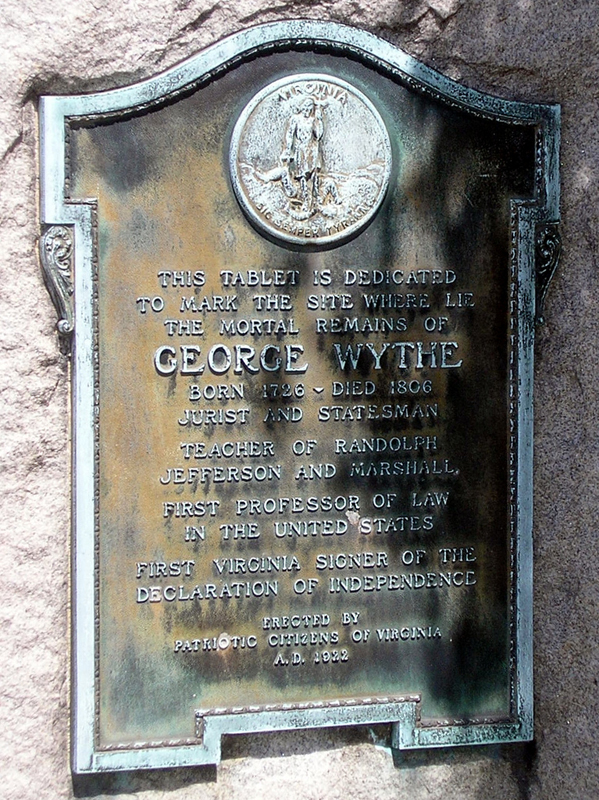Difference between revisions of "Wythe Monument"
From Wythepedia: The George Wythe Encyclopedia
m |
|||
| Line 1: | Line 1: | ||
| − | [[File:WytheMonument.jpg|thumb|right|400px|<p>Monument to mark George Wythe's burial at St. John's Episcopal Church, East Broad Street, Richmond, Virginia.</p><p>A smaller plaque at the base was placed by Descendants of the Signers of the Declaration of Independence, Inc., to indicate Wythe was a signer.</p>]]In 1922, a monument was erected by "patriotic citizens of Virginia" in the churchyard of St. John's Episcopal Church in Richmond, Virginia, to "mark the site where lie the mortal remains of George Wythe." Wythe had been buried without a tombstone, and the exact location of his grave had been forgotten. As early as 1884, Wythe's namesake George Wythe Munford wrote, "There is no monument or other mark to designate the spot where his remains repose; but it is believed he was buried on the west side of the church, near the wall of that building."<ref>[http://archive.org/details/twoparsonscupids00munf ''The Two Parsons; Cupid's Sports; The Dream; and The Jewels of Virginia],'' (Richmond, Virginia: J.D.K. Sleight, 1884), 429.</ref> In fact, the <em>Richmond Enquirer</em> | + | [[File:WytheMonument.jpg|thumb|right|400px|<p>Monument to mark George Wythe's burial at St. John's Episcopal Church, East Broad Street, Richmond, Virginia.</p><p>A smaller plaque at the base was placed by Descendants of the Signers of the Declaration of Independence, Inc., to indicate Wythe was a signer.</p>]]In 1922, a monument was erected by "patriotic citizens of Virginia" in the churchyard of St. John's Episcopal Church in Richmond, Virginia, to "mark the site where lie the mortal remains of George Wythe." Wythe had been buried without a tombstone, and the exact location of his grave had been forgotten. As early as 1884, Wythe's namesake George Wythe Munford wrote, "There is no monument or other mark to designate the spot where his remains repose; but it is believed he was buried on the west side of the church, near the wall of that building."<ref>[http://archive.org/details/twoparsonscupids00munf ''The Two Parsons; Cupid's Sports; The Dream; and The Jewels of Virginia],'' (Richmond, Virginia: J.D.K. Sleight, 1884), 429.</ref> In fact, the <em>Richmond Enquirer</em> commented, at the time of his death in 1806, that "the venerable GEORGE WYTHE needs no other monument than the services rendered to his country, and the universal sorrow which that country sheds over his grave."<ref>''Richmond Enquirer,'' June 10, 1806, 3.</ref> |
[[File:WytheMonumentDetail.jpg|thumb|right|400px|border|Detail of bronze plaque inscription on the Wythe monument, featuring the Seal of the Commonwealth of Virginia.]] | [[File:WytheMonumentDetail.jpg|thumb|right|400px|border|Detail of bronze plaque inscription on the Wythe monument, featuring the Seal of the Commonwealth of Virginia.]] | ||
Revision as of 16:22, 20 June 2013
In 1922, a monument was erected by "patriotic citizens of Virginia" in the churchyard of St. John's Episcopal Church in Richmond, Virginia, to "mark the site where lie the mortal remains of George Wythe." Wythe had been buried without a tombstone, and the exact location of his grave had been forgotten. As early as 1884, Wythe's namesake George Wythe Munford wrote, "There is no monument or other mark to designate the spot where his remains repose; but it is believed he was buried on the west side of the church, near the wall of that building."[1] In fact, the Richmond Enquirer commented, at the time of his death in 1806, that "the venerable GEORGE WYTHE needs no other monument than the services rendered to his country, and the universal sorrow which that country sheds over his grave."[2]
Contents
- 1 Association for the Preservation of Virginia Antiquities
- 2 Reports of the Virginia State Bar Association
- 3 Sons of the Revolution in State of Virginia
- 4 Reports of the Virginia State Bar Association
- 5 Proceedings of the Virginia State Conference of the Daughters of the American Revolution
- 6 References
Association for the Preservation of Virginia Antiquities
1900
Reports of the Virginia State Bar Association
1920
Letter from Arthur B. Clarke, President of the Virginia Society of the Sons of the American Revolution
1921
Special Committee to Aid in Securing Suitable Marker for Grave of George Wythe: Robert M. Hughes, of Norfolk; Eppa Hunton, Jr., of Richmond; and Eugene C. Massie of Richmond.
Sons of the Revolution in State of Virginia
April, 1922, p. 38
Reports of the Virginia State Bar Association
1922
June, 1922. Report of Committee on Library and Legal Literature
Report of Special Committee on Memorial to George Wythe
Proceedings of the Virginia State Conference of the Daughters of the American Revolution
October, 1922. Report of State Historian, Mrs. Robert L. Pierce. Commonwealth Chapter reports:
On Revolutionary Day, May 24th, [Sons of the Revolution in State of Virginia, and the Sons of the American Revolution] and the William Byrd Chapter joined with us in services in old St. John's Church to commemorate the birthday of Patrick Henry and to unveil a tablet to George Wythe, the great Chancellor, and one of the Virginia Signers of the Declaration of Independence. Rev. Hugh Sublett conducted the ceremonies and Governor Trinkle, Dr. Freeman and Mr. George Bryan spoke. Passing out to the churchyard, a wreath was laid on the tablet by the Regent of the Chancellor Wythe Chapter [Mrs. Manly B. Ramos].
References
- ↑ The Two Parsons; Cupid's Sports; The Dream; and The Jewels of Virginia, (Richmond, Virginia: J.D.K. Sleight, 1884), 429.
- ↑ Richmond Enquirer, June 10, 1806, 3.

